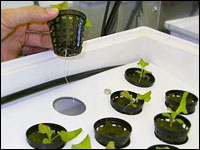
The Future of Farming, Part 2: New Growth Patterns
“Growing crops is only half the job,” AG Kawamura said.
“The other half is marketing — and if you don’t do that right, you will probably go out of business,” Kawamura, founding member of Orange County Produce and head of the 114-acre Orange County Great Park Farm, told TechNewsWorld.
Taking a crop directly to farmers’ markets, grocery stores and restaurants to sell is only a small part of the marketing job for producers and growers. To succeed, they also have to embrace the full scope of agri-marketing services, including brand strategy, online/digital strategy, creative development, media planning, direct marketing, public relations and market research.
Some large California growers are showing the way in their “agri-branding” efforts to promote and sell their hydroponically grown crops.

Tanimura & Antle, for example, is one of the largest independent U.S. lettuce growers. The company’s Artisan family brand of fresh, field-grown produce is complemented by its Living Lettuce brand grown hydroponically in a state-of-the-art greenhouse in Tennessee.
Houweling’s Tomatoes, meanwhile, is a leading North American greenhouse grower. In 2012, Houweling’s Tomatoes launched a branding and marketing effort that features CEO Casey Houweling and his signature as a symbol of his commitment to a new slogan, “Mastery Under Glass.”
Then there’s Hollandia Produce, a multifaceted agricultural concern specializing in greenhouse-grown vegetables. The company produces and markets Live Gourmet brand butter lettuce, upland cress and 3-n-1 lettuce.
Go Green Agriculture, on the other hand, is a family farm that grows its Happy Living brand of green and red butter lettuce and bloomsdale spinach hydroponically in urban “mini-farms” using cutting edge technologies.
‘Your Billboard to the World’
“Your website is perhaps the single most important marketing tool you have,” wrote Jane Eckert, founder of Eckert AgriMarketing. Eckert AgriMarketing helps farmers sell directly to consumers, diversify operations and become tourist destinations.
“A website has literally become your billboard to the world,” Eckert explained. “A website has replaced your local newspaper classified advertising and yellow page listings to become the — and I mean, THE — informational source of choice for local and distant prospects to be attracted to visit your farm.”
Clean Tech
“Clean” tech innovations can help large-scale agriculture increase efficiencies, reduce waste and address concerns about toxicity, safety and the environment, according to “Companies and Breakthroughs Most Likely to Help the World Produce More Food with Less,” a 2012 report from research and advisory firm Kachan & Co.
“Agricultural technology innovation hasn’t been as high profile as other clean-tech sectors like renewable energy or transportation, but it potentially has more immediate importance to us as a species, particularly if we start seeing crisis events around food availability,” said Kachan analyst Shannon Payne, who was primary author on the report.
“While attracting only a fraction of the capital of other clean-tech segments, there’s an active exit climate, with innovative companies consistently being acquired by leading firms,” Payne explained.
Community Supported Agriculture
Community supported agriculture is an alternative, locally based economic model of agriculture and food distribution that allows city residents to have direct access to high-quality, fresh produce grown locally by regional farmers.
A CSA season typically runs from June through November. However, some farmers offer winter shares that come with a variety of root vegetables and greens. Members of a CSA purchase a “share” of vegetables from a regional farmer. Weekly or bi-weekly, from June until October or November, the farmer delivers that share of produce to a convenient drop-off location in the member’s neighborhood.
Since the 1980s, community supported farms have been organized throughout North America — mainly in New England, the Northwest, the Pacific coast, the Upper Midwest and Canada. North America now has at least 13,000 CSA farms, of which 12,549 are in the U.S., according to a 2007 U.S. Department of Agriculture report.
Share prices vary from CSA to CSA, according to LocalHarvest, an organic and local food website. Shares are sold as full shares — which feed two to five people — and half shares, which feed one to three. Prices range from US$200 to $500.
Share prices are mostly determined by overhead costs of production, but are also affected by share prices of other CSAs, variable costs of production, market forces and income levels in the community. Many CSAs have payment plans and low-income options.
Medical Marijuana
One crop that sells well year-round without standard marketing or branding is medical marijuana.
Marijuana growers were early pioneers in the art of the indoor cultivation and grow rooms. Growing marijuana hydroponically indoors gives growers a yield-boosting opportunity they don’t have when they grow outdoors: They get to control the environmental and input factors that influence how big their buds become and how much THC they contain.
Associated with medical marijuana are new jobs, and not just in production: A national survey of the medical marijuana market listed “hydroponic equipment” and “software development” as being among “significant business opportunities that have emerged in ancillary businesses” related to the market.
Amounting to some $1.7 billion in 2011, the medical marijuana market is on its way to reaching $8.9 billion by 2016, according to a report from See Change Strategy, which based its findings on information obtained through 300 survey responses and multiple interviews with people involved in the medical marijuana industry.
Marijuana Business Daily, the leading industry news outlet, puts today’s legal national medical marijuana market at between $1.3 billion and $1.5 billion.
Think tank Cato Institute, meanwhile, estimated U.S. total illicit marijuana expenditures at $18.1 billion in 2010 report and projected a future legal U.S. marijuana market of $13.61 billion.

Medical marijuana is being used across the nation to treat people with qualifying medical conditions like AIDS, multiple sclerosis, cancer, chronic pain and a lot of other ailments. Recent studies have shown that about 24 million people in America are using (or are eligible to use) medical marijuana.
During the past 15 years, led by California, 15 states plus the District of Columbia have adopted laws permitting some form of marijuana consumption or distribution for medical use. These laws have been adopted by public referendums as well as legislation.
Two states, California and Colorado, dominate this nascent industry, combining to represent 92 percent of the wholesale and retail sales across the country. California still has the largest medical marijuana market in the country, with roughly $700 million to $900 million in annual retail sales, according to the Marijuana Business Factbook 2013. Colorado hosts the fastest-growing and most business-friendly market.
Despite the attractive numbers, cannabis growers face a number of challenges. Most notably, the possession and distribution of marijuana remains illegal under federal law.
Many businesses operate with the ever-present risk of being shut down or experiencing a property seizure without notice. Many businesses cannot make standard deductions for business expenses and have difficulty securing standard banking and financial services.
The industry suffers from inadequate capital investments, lack of experienced executives and operators, changing local regulations and interactions with illegal marijuana markets. Nevertheless, the momentum is on the side of growers and the overall industry
‘It Is an Exciting Time’
Greengro Technologies, a provider of eco-friendly green technologies and indoor and outdoor agricultural science systems, recently signed an agreement to provide facility design and consulting services for a major planned Arizona medical cannabis cultivation facility.
The company expects the deal to be worth $300,000 plus ongoing maintenance services amounting to several hundred thousand dollars per year. The parties will announce the full scope of design services, equipment and service contracts after final approval under the Arizona Medical Marijuana Act.
“It is an exciting time to be part of this emerging market,” said James Haas, CEO ofGreengro Technologies. “As medical cannabis comes to the forefront of discussion in our society, it is imperative that we create good models that work for regulatory authorities, patients and businesses,” Haas told TechNewsWorld. “As legal guidelines become clearer, businesses will invest, patients will have safe access and governments will gain billions in new tax revenues.”
Success Without Shortcuts
Success in a CEA business requires market security to ensure financial sustainability and for obtaining the financing for greenhouse development, according to Gene Giacomelli, director of the Controlled Environment Agriculture Center and a professor in the Department of Agriculture and Biosystems Engineering at the University of Arizona.
“Greenhouse crop production is a real and knowledge-driven, biologically based venture, and as such it requires learning, experience, patience and an entrepreneurial nature to succeed,” Giacomelli told TechNewsWorld. “There are few shortcuts to success and, as such, the fundamentals of plant needs for growth must be understood and applied for success.”
Regulation and Funding
Aquaponics — the sustainable food production system that mixes vegetable and herb crops and aquatic life in a closed-loop, recirculating symbiotic environment — is the leading CEA technology, but there are two primary hurdles in the U.S. to its wide-scale development.
One is regulation, and the other is funding, according to Rebecca Nelson, co-owner of Nelson and Pade, which markets its Clear Flow Aquaponic Systems for commercial ventures and other applications.
“When you combine raising and selling fish and vegetables, you fall under many regulatory umbrellas that were never written to exclude aquaponics, but in some cases they either exclude it or make it very difficult to get started,” Nelson explained. “In addition, every state, city, county and municipality can have different rules and regulations, so it is a challenge to figure out what you need and who you need to talk to from a regulatory point of view.”
Regarding funding, aquaponics is a fairly new industry and producers don’t have hundreds of models to show a bank, said Nelson.
“Also, there are currently a plethora of new websites that suggest that you can start an aquaponics business with no background or investment,” she told TechNewsWorld. “To be successful in the aquaponics business, you need a proper business plan, the right aquaponics and enough funding for the startup.”
David Bell, chief marketing officer for Houweling’s Tomatoes, points to regulation and a stifling system that does not provide businesses enough opportunity to innovate efficiently as the major obstacles to success in CEA.
“Additionally, competing interests among various levels and within governments creates a bureaucratic tug of war,” Bell told TechNewsWorld. “Making it easier for business to take leaps of innovation is the biggest opportunity.”
‘It Costs a Lot of Money’
CEA is no panacea, cautions Danilo Lopez, principal at Novelle Consulting.
“It has provided superior-quality products — albeit still a limited range, but growing — at competitive market prices,” Lopez told TechNewsWorld. “It has enabled production under difficult environmental conditions; it has created wealth for entrepreneurs and risk-takers. It has favorably impacted agriculture.
“However, just like any new technology, one must carefully weigh the benefit, cost and adoption rate,” Lopez warned. “The producer that masters the complete supply chain is the one who would most likely succeed.”
Indeed, “the real obstacles to this form of farming, just as much now as back when hydroponic farming was first conceived, are related to capital,” suggested blogger Alex Tiller. “It costs a lot of money to start a farm — but it costs even more to start a farm inside a building.”




















































